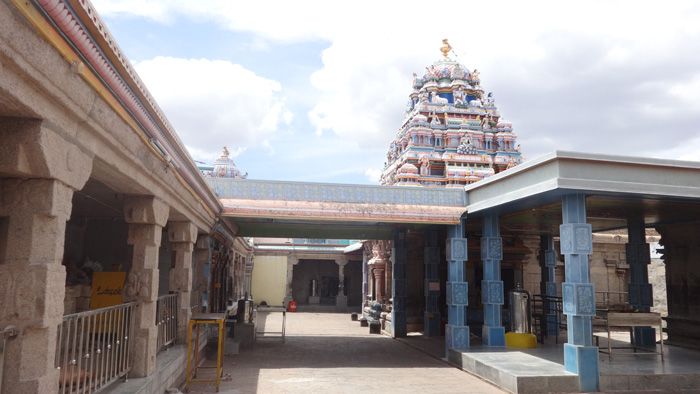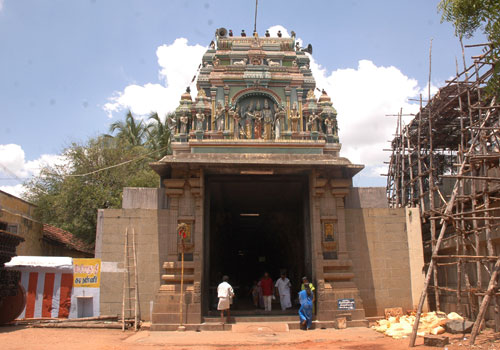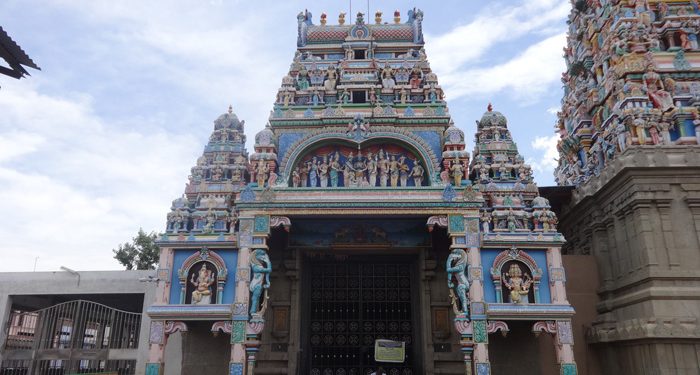Poovananathar Temple is one of the ancient temples of Kovilpatti, Shivan.Thoothukudi District, the place which is considered as the Pearl City of South India.Arulmigu Poovananathar is a form Shivan.The temple is one of the oldest structures (above 1200 years) in Kovilpatti, Thoothukudi District.
Shrine’s History
As in Madurai, the importance goes to Goddess Shenbagavalli in this temple. There are two women securities (Dwarapalakis) in the shrine. While the Alankara (dressing) is done in accordance with form (standing or sitting) of the deity in all temples, in this temple the Alankara is done in a sitting form to the Goddess, though the original form is a standing one. The place has the reputation that Lord Rama worshipped Lord Shiva here. As two snake leaders Chadungan and Paduman worshipped Lord Shiva here with Poovana flowers, the Lord is named Poovananathar. The story that Sage Agasthya came to South to balance the earth level when it sank at north during the wedding of Lord Shiva with Mother Parvathi is popular.
On his way to Pothigai hills, the sage destroyed two demons Vilvalan and Vadhabi and also relieved himself of the Brahmmahati dosha that afflicted him due to killing of the demons. He also created the Agasthya spring as requested by the sages of Ponmalai hills.One Vamanan belonging to Shivakuzhu was born as the king of Vembakkottai in the name of Shenbagan as ordered by Nandhi, the bull vehicle of Lord Shiva. He built the temple as advised by the Lord. As the temple is built by king Shenbagan, Mother is named Shenbagavalli. Later, the temple was renovated by Ullamudayan belonging the 10th century. For total cure of prolonged illness, for a wedlock of imagination, children, progress in business, high farm yields, people place their prayers at the feet of the Lord and Mother and it is firmly believed that prayers do not go in vain.Besides usual abishek and pujas, devotees light lamps in Ambal shrine, offer vastras and perform milk and sandal abishek to the Lord with dhoties. They also feed the visitors to the temple. Also, one Vamanan belonging to a Siva group was born as the king of Vembakkottai due to the curse of Nandhi and had his curse relieved by the Pujas to Poovananathar. The temple was built by King Shenbagan whose name the Goddess Shenbagavalli bears. The temple was renovated in the year 1929. Prayer motto, offerings, specialities, importance of the place, general information, festivals and history details are as follows.Devotees coming to this temple carry with them benefit of healing of ailments and mental peace and family happiness and the abundant grace of Mother Shenbagavalli. They are also successful in their business ventures.
Devotees offer Abishek in milk, sandalwood and adore the deities with Sari and Dhoti. Annadhanam, as in other temples, is important here also.As in Madurai, here too, the prominence goes to Devi, In the entrance are seen two powerful Dwara Balakis. While it is the practice in other temples to adore the Devi in the form she is installed, in this temple, the Goddess is adored in a sitting position. Sri Rama offered his worship in this temple. The name, Poovananathar was derived from the worship of two snake leaders Thungan and Padhuman. Goddess Shenbagavallis royal standing and promising posture adds more grace to the temple.

Legends Associated with This Shrine
The legend goes that in Tirupuvanam, a dancer called Ponnaiyal lived. As a staunch devotee, she spent all her earnings from the dancing programmes in feeding Shiva devotees. She had a desire to sculpt Lord Poovananathar in pure gold. To fulfil her desire, Lord came in the guise of a siddha and advised her to melt all the brass, lead and copper articles in the house at night which will turn into gold. The dancer followed the advice of the Siddha and her joy knew no bounds to see adequate gold to make the idol of the Lord. With the gold she got through the alchemy miracle, the dancer made out a beautiful idol of the Lord and in her ecstasy, she embraced the idol and kissed it on the cheek.
The nail symbol of Ponnaiyal is visible on the procession deity. During the Puranic Age, one Darma Yagnan was carrying his fathers ashes ? asthi to Rameswaram from Kasi-now Varanasi. He stayed in this place for a while for rest. His friend accompanying him opened the pot containing the asthi but was surprised to find flowers in the pot and not asthi. But he did not reveal the truth to his friend. Reaching Rameswaram, while opening the pot, they found only asthi and not the flower. Now, the friend told Darmayagna what he found earlier. They returned back with the pot to Tirupuvanam and found the flower when they opened the pot. As what was simply asthi-ash in Kasi turned into a flower in Tirupuvanam, the place is considered 16 times holier than Kasi. The proverb here goes it is a veesam more than Kasi? claiming greater reputation than Kasi.
Those unable to go to Kasi to immerse the ashes of the departed ones in River Ganga do it here in Vaigai River and light the Moksha Deepa. When saint Tirugnanasambandar visited this place, he saw Shivalingas in every particle of river sand and could not walk on the banks to reach the other side of the river. He prayed to the Lord singing His praise from where he was. Nandhi, the bull vehicle of Lord Shiva was hiding the Lord from Gnanasambandar. Lord Shiva asked the Nandhi to move to the side to grant His darshan to the saint. We see Nandhi in the temple a little away on the side representing this event.

Shrine’s Map Location and How to Go There
By Road
Nearest Bus Stand is Kovilpatti Old Bus Stand, V.O.C. Nagar (only 1.0 km).This will connect all the places to Kovilpatti,Tuticorin.
By Rail
The Nearest Railway Station is Kovilpatti Junction.
By Air
The Nearest Airport is Tuticorin Airport, Airport Road, Tuticorin.Which is a National and International Airport.
Shrine Timings
The temple is open from 6.00 a.m. to 11.00 a.m. and 4.00 p.m. to 8.00 p.m.
Events Celebrated at This Shrine
10 day Vasantha Utsav during May-June, Goddess Bangle festival-Aadi Pooram in July-August, 10-day Purattasi Navarathri in September-October, 12day Wedding festival, Chithirai-theertham Tamil New Year festival in April-May are the important and main festivals in the temple, besides Deepavali, Pongal and Tamil and English new year days. The crowd in the temple would be huge on the new moon, full moon days and on Prdosham days.













































